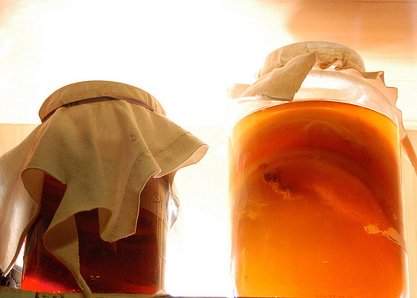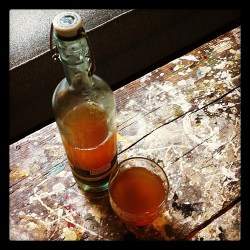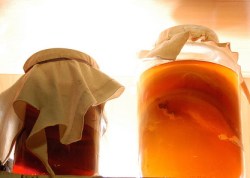As a fizzy, refreshing fermented nonalcoholic beverage, kombucha has lately taken the world by storm and found its way into even the dustiest corner stores in San Francisco. This isn’t its first resurgence. People have been brewing kombucha and touting its miraculous healing powers for a long time. In fact, it had its big debut in North America after World War I: Picture flappers sipping kombucha. And yet somehow it always seems like a recent alternative health fad.
I’m not going to bother with the controversy over the health benefits of kombucha. It’s a mysterious, ancient elixir fermented with a thick rubbery “mushroom” (the mother), which is actually a symbiotic colony of bacteria and yeast (also called a SCOBY). Nobody has ever found a kombucha SCOBY in the wild, but it entered recorded history around 250 BCE in China. The main thing is, it’s a delicious, nonsoda, (mostly) nonalcoholic, tart, fizzy, refreshing beverage.
Here’s the other thing, though. Home-brewed kombucha is one of the least expensive ways to make vinegar. Its only ingredients are sugar and tea, and if you let it ferment long enough, you’ll get a highly acidic liquid, useful for all the purposes acidic liquids are good for, like cleaning windows, rinsing hair, and making salad dressing. [There’s more on that in the book.]
The common wisdom is that to make your own kombucha, you have to buy a kombucha mother for a lot of money online or acquire one from your housemate’s boyfriend, who got it from a girl on Craigslist in exchange for a ride to Portland. Sadly, the girl on Craigslist may have a subpar kombucha mother. It’s hard to tell, but not all kombucha mothers are the same. A neglected kombucha mother, or any of its descendants, will fail to produce delicious, fizzy, happy kombucha — and it may even breed fruit flies.
Commercial kombucha brewers work with very high-quality kombucha mothers. You can propagate a high-quality kombucha mother of your own with just a bottle of raw kombucha from your favorite kombucha brand, a little care, some sugar, and good black tea. Yes, you can use nothing more than a bottle of storebought kombucha as a starter for your own never-ending supply of kombucha.
Here’s why. Every bottle of raw kombucha has very small strands of kombucha mother in it. Your job is to feed those strands until they form a strong kombucha mother. Too much food, and the kombucha won’t be strong enough to culture the substrate, and it will mold. Too little food, and it won’t grow.
Growing the mother
First, select an excellent bottle of plain or gingered kombucha. It should have as many yeasty filaments floating in it as possible, and it must be raw. Heat kills kombucha. You can drink some of the kombucha if you like — just leave all of the sediment and stringy bits in the bottle, and at least a half-cup of liquid. Next, ready the kombucha food.
In a small saucepan, heat one cup of water to boiling. Add two tablespoons white sugar, and return the liquid to a boil until the sugar is dissolved. Turn off the heat and add one bag of organic black tea (or one tablespoon of loose leaf) and let the mixture cool at room temperature until it no longer feels the slightest bit warm to the touch. Remove the tea bag or strain the tea. Pour all the contents of the kombucha bottle into the sugar-tea mixture: the sediment, the half-cup of kombucha liquid, and the stringy things (these will turn into the kombucha mother!), and put it all in a glass quart or pint jar. Cover the jar with a cloth and a tight rubber band to keep bugs out, and place it in a warm, dark, safe spot. Note that the kombucha liquid is necessary to keep the mixture sufficiently acidic. If the liquid is not acidic, mold will grow.
Keep an eye on the kombucha. In a few days or a week, it should start to grow a thin film over the surface. The film will thicken and become the kombucha mother. If any mold appears, discard everything and start over — but that shouldn’t even be a possibility if you have enough acid in the liquid.
After one or two weeks, when the film is about one-eighth inch thick, you’ll need to give the mix another little boost of food. It’s not yet strong enough to culture a lot of kombucha for you to drink; right now it’s just growing.
This time, make one quart of tea. Heat four cups of water to the boil, add one-third cup of sugar, and steep with two tea bags or two tablespoons of loose black tea. When the liquid cools completely, remove the tea leaves, and put the baby kombucha and all the liquid and sediment in a large glass jar or bowl with the tea. Cover it tightly and watch it carefully. The kombucha mother should thicken significantly over the space of two weeks. When the mother is between one-quarter and one-half inch thick, you can use it to make yourself a batch of kombucha.
Brewing kombucha for refreshment
Bring three quarts of filtered water to a boil. (If your water is chlorinated and you don’t have a filter, leave the water sitting uncovered overnight to evaporate the chlorine.) Add one cup of sugar and return to a boil until dissolved; turn off the heat and add four tea bags (or four tablespoons loose leaf) black tea. Let cool completely to room temperature. Remove the tea bags or leaves, and put the liquid in a one-gallon glass jar. Pour in one or two cups of finished kombucha liquid from the last batch (to keep everything acidic) and place the entire kombucha mother on top. It’s OK if it sinks. Cover it securely with cloth and a rubber band, and place it in a warm, dark cupboard for seven to 10 days. A new kombucha baby will grow on the surface of the liquid.
When the kombucha baby is one-eighth to one-quarter inch thick, taste the kombucha. If it doesn’t taste too sweet, you can harvest the liquid, leaving one or two cups in the bottom of the jar with the mother. You can give the baby kombucha away or just keep it in the jar along with the original mother. If you want continuous kombucha production, you can start brewing a second batch with the mother immediately, or just leave the mother in the liquid until you next need it. It keeps quite well for many months, if the jar is stored in a dark, cool cupboard and covered securely with fine cloth to keep out bugs.
At this point, the liquid you harvested will be flat. To get it fizzy, you’ll need to put it through a secondary fermentation in airtight containers. Put one teaspoon of sugar in the bottom of each 16-ounce bottle or jar (or the proportionate amount) and fill it with kombucha to within a half-inch of the top. Cap all the bottles securely — any ordinary screw-cap or swing-top bottle will work, so long as it keeps out air — and put the bottles in the cupboard for one week. If the room temperature is very warm, you might want to check them earlier to prevent any explosions.
You can also add flavorings when you bottle the kombucha: ginger, spices, raisins, or a few tablespoons of fruit juice. Or perhaps you want to brew your own medicinal tonics. The acid and weak alcohol content of kombucha are better at extracting the active components of many medicinal herbs than is plain water. Most anything you might brew as a tea can be added to a bottle of kombucha during its secondary fermentation, with potent results. For example, a few tablespoons of dried dandelion root per bottle create a wonderfully bitter liver tonic.
Once the bottles are fizzy, store them in the refrigerator to slow down their fermentation. While kombucha is quite delicious and refreshing, don’t guzzle it, or you’ll find yourself with a stomachache instead of boundless health.
Reprinted from The Lost Arts of Hearth and Home: The Happy Luddite’s Guide to Self-Sufficiency by Ken Albala and Rosanna Nafziger Henderson by arrangement with Perigee, a member of Penguin Group (USA) Inc., Copyright (c) 2012 by Ken Albala and Rosanna Nafziger Henderson.






